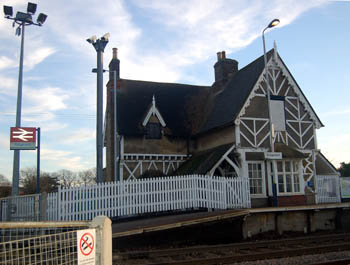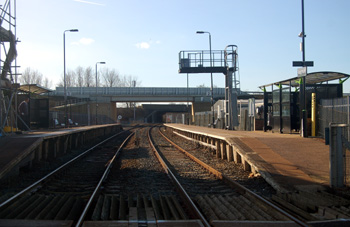Ridgmont Station

Ridgmont Station January 2008
By one of those strange accidents of history and geography Ridgmont station is in Husborne Crawley. It lies in Station Road and is one of the stations on the Bletchley to Bedford line. This railway line was the first extensive piece of track laid in the county.
The idea of the railway was first mooted as early as 1840 when the Duke of Bedford's Woburn steward, T. Bennett wrote to his agent in London, C. Haedy: "I met with Mr. Elger [a builder] at Bedford, and had some conversation with him as to this being a good time for selling Building Ground in Bedford or not…Mr. Elger says that should the Railway go on, it is impossible to say what alteration may take place in the value of property in the Town….There was a meeting held yesterday about the Railway, and the project was most favourably entertained by the Meeting. Mr. Whitbread advocates it most strenuously, and will offer every support he can to it, and so do many other proprietors on or about the Line. I think that if the Manchester people make up their minds that a second line of rail is required, they will carry it, and if Bedford does not take advantage of the Line, some other Town probably will".
In the event it was not Manchester but Birmingham that provided the impetus as Bennett wrote to Haedy in 1844: "Bedford was quite alive yesterday about Railways - it appears the Birmingham people are determined on a branch from Bletchley (near Fenny Stratford) to Bedford, the Terminus about the Infirmary, the late Mr. Gotobed's field or one of the Duke's will be chosen. The line then proceeds through Kempston, Wootton, Marston, Lidlington, tunnel through Brogborough Hill, come out about Holcot, over the lower part of Aspley to Wavendon and Sympson and Bletchley".
The Duchess of Bedford cut the first sod at the half way point, in Husborne Crawley, just north-east of the later station (now in the civil parish of Brogborough) early in 1845 and by October 1846 the line was finished and ready to be inspected, but heavy rains caused some minor landslides and opening day did not take place until 17th November 1846. By 1848 there were seven stations, the termini at Bedford, St. John's and Bletchley as well as stations at Marston Moretaine, Lidlington, Ridgmont/Husborne Crawley, Woburn Sands and Fenny Stratford. The Bedford Arms (originally the Richmond Arms) was built a few yards from the station by an enterprising Ridgmont farmer to provide refreshment.
![A plan of Ridgmont Station [Z1032-Rid2]](/CommunityHistories/HusborneCrawley/HusborneCrawleyImages/A plan of Ridgmont Station [Z1032-Rid2]_350x215.jpg)
A plan of Ridgmont Station [Z1032/Rid2] - to see a larger version please click on the image
Further stations were built in 1905. These were actually halts, designed for motor trains which would stop both at the main stations and these smaller halts. The halts were at Kempston & Elstow, Kempston Hardwick, Wootton Broadmead, Wootton Pillinge, Husborne Crawley, Aspley Guise and Bow Brickhill. The halts were at ground level and special coaches with retractable steps were built to serve them.
Husborne Crawley halt lay just half a mile from Ridgmont Station and had two passenger shelters, one either side of the tracks and the gatekeeper's house as it lay at the spot the railway crossed the road from Husborne Crawley to Marston Moretaine. When the flyover and bridge was built at this point in the 1960s the gatekeeper's house was demolished. The halt itself had been closed in 1949.
Ridgmont Station house was listed by the former Department of Environment in June 1977 as Grade II, of special interest. It is mostly roughcast render with ornamental applied timber framing. Other parts of the building are in yellow brick with red brick dressings. There are 20th century tiles to most roofs, although some retain fishscale tiles. The station house has one storey and attics built in a "picturesque style". The down platform of the station has a plank built shelter.
Directories for Bedfordshire, which were not published annually but every few years, give the names of the station masters from 1864 to 1920 and the following names are taken from these directories. The dates are those of the first and last appearance of a name, not the full span of dates of incumbency:
- 1864: Joseph Clarke;
- 1869: W. Wheeler;
- 1877-1903: Frederick Wheeler;
- 1906-1914: William Abbey;
- 1920: John Scotney

Ridgmont Station looking south Febrary 2011